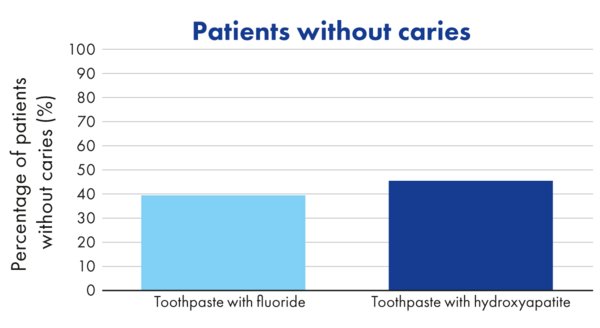Introduction
The efficacy of hydroxyapatite could be proven in several in situ and in vitro studies for treating caries. What is missing is in vivo studies that confirm these results. Clinical studies on hydroxyapatite are only available from the fields of periodontitis prophylaxis and treating pain-sensitive teeth. A study comparing hydroxyapatite and fluoride in caries prophylaxis has not been available until now.
Question
Is hydroxyapatite as clinically effective as fluoride in caries prophylaxis?
Material and methods
This multicentric, double-blind, randomised clinical study was conducted at five university hospitals in Germany. The test subjects were between 11 and 25 years of age, constituted a caries risk group (orthodontic treatment) and were recruited upon first presentation. At the beginning of study, no test subjects had caries. A professional teeth cleaning was performed before the orthodontic treatment. The tooth status was assessed using the ICDAS code (International Caries Detection and Assessment System; www.icdas.org). An ICDAS code of 1 or greater was set as the primary endpoint. The study was conducted over 6 months. Studies prove that caries can be detected in this risk group after 6 months. The test subjects were called in regularly for check-ups, during which the tooth status was determined.
The test subjects were randomly divided into two groups after they were recruited: The test group was given a hydroxyapatite toothpaste and the control group an amine/stannous fluoride toothpaste.
Results
A total of 150 test subjects were recruited and divided equally into the two groups. While 60.9% developed caries according to ICDAS 1 in the amine/stannous fluoride group, this kind of carious change in enamel could only be seen in 54.7% in the hydroxyapatite group.The difference for ICDAS 2 was even greater: in the amine/Stannous fluoride group 34.8% developed caries, whereas only 23.4% of the test subjects in the test group who cleaned their teeth with hydroxyapatite toothpaste were diagnosed with ICDAS 2. No statistically significant differences could be proven.
Conclusion
A hydroxyapatite toothpaste is clinically as effective in preventing caries as fluoride toothpaste.
Read more information in the study titled "Impact of a non-fluoridated microcrystalline hydroxyapatite dentifrice on enamel caries progression in highly caries-susceptible orthodontic patients: A randomized, controlled 6-month trial".
Sources: Schlagenhauf, U. et al. Impact of a non-fluoridated microcrystalline hydroxyapatite dentifrice on enamel caries progression in highly caries-susceptible orthodontic patients: A randomized, controlled 6-month trial. J. Invest. Clin. Dent. 10, e12399 (2019).
Here you can read the review (German translation) of the study entitled: "Comment on the study: Microcrystalline hydroxyapatite is not inferior to fluoride in clinical caries prevention: A randomized, double-blind, non-inferiority study" by Professor Amaechi from the University of Texas at San Antonio, USA.


